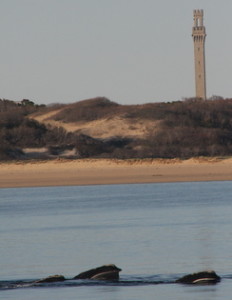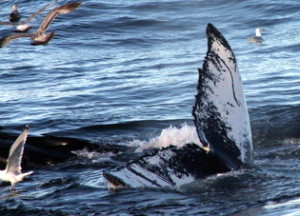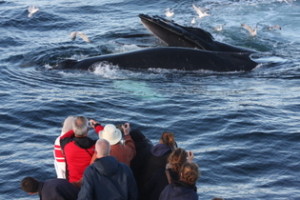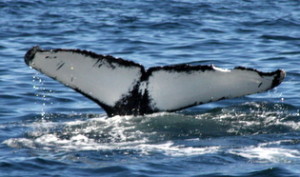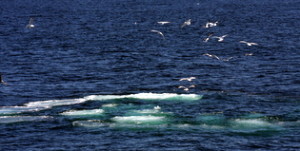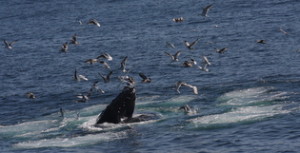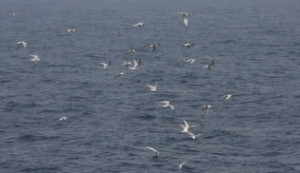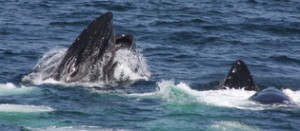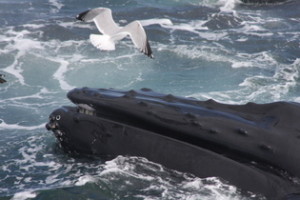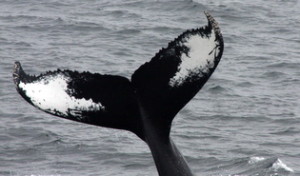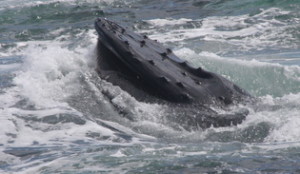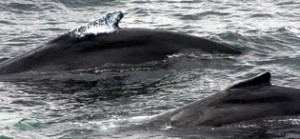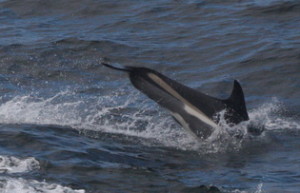Dolphin Fleet Naturalist Notebook- 30 April to 6 May
We had amazing looks at North Atlantic right whales all day and with a beautiful sunset as a backdrop on April 30th. Although they generally start to leave Cape Cod Bay by the end of April, we are still averaging about 30 individuals per trip. In the following photo, five right whales are headed straight for us, with their mouths wide open. Despite the narrow appearance of their rostrum, their mouths can be 6-8 feet deep!
Soon, they will be leaving the bay, where a large majority of the population will spend the late spring and early summer in the Great South Channel. In the mean time, other aerial surveys are also finding members of the right whale population in Rhode Island Sound and off the coast of Nantucket.
On the morning of May 1st we had around 14 right whales skim feeding away between Wood End and Race Point. We can only watch the right whales from a distance of 500 yards, so after we had gotten some good passing looks, we had a report from a fishing boat that there was a big group of humpbacks to the East of Stellwagen Bank. We headed offshore to find between 9 and 11 humpbacks, including a new mother calf pair. Ventisca, a 10 year old female, is here with her second calf!
By the afternoon, the group of humpbacks had almost doubled in size, with Patchwork, Echo, Circus, and Vulture and Tongs with their calves all making appearances. We also had a great look at a fin whale mother and calf. While we tend to see a lot of humpback mom/calf pairs on Stellwagen, it is a rare occurrence to see a fin whale with her young.
When we returned in the afternoon, the humpback group had thinned out, but they had started to feed! Mural, Falcon, and Nocturne’s 2008 calf could be seen kicking and lunging under huge flocks of birds.
It gave us a great opportunity to compare the feeding styles of right whales and humpbacks. Although they are both baleen whales, they filter feed very differently. Right whales are grazers or skim feeders, and will open their mouth and swim forward, filtering out microscopic copepods which enter their mouths. Essentially, they rely on currents and other oceanographic processes to aggregate their food for them. Humpbacks, on the other hand, will target specific prey, often using their powerful tails to aggregate schools. They will then ferociously lunge through these huge schools, often on their sides.
The feeding continued into May 2nd, with Falcon, Terrace, Mural, Hancock, Barb, Centipede, Perseid, and Tongs and calf all making appearances.
Centipede
Some humpbacks created huge rings of bubble columns to corral their food.
They would then emerge from the center of the bubble net with their mouths filled with fish.
On a note marginally related to marine mammals, we also caught sight of a Christmas tree floating around on Stellwagen. This reminds us how far our trash can travel after we get rid of it. Garbage, especially plastic, can have a devastating effect on marine life. This week, scientists confirmed that a Gervais’ beaked whale that washed up in Puerto Rico died as a result of having over 10 pounds of plastic in its stomach. Click here for the article.
Although right whale numbers in the bay are noticeably dwindling by May 3, we still managed to watch one breach during the morning trip. We are now seeing about 7 right whales on every trip. Still exciting considering that their current global population is estimated at only 473 individuals! This week, the Boston Channel also went out with the Dolphin Fleet to report on the record number of right whales seen in Cape Cod Bay this season.
The real draw today was the continuation of the humpback feeding bout that we’ve been watching over the past few days. Humpbacks surfaced quickly with big mouthfuls of fish as common terns and other sea birds swooped around their heads.
In the pile we saw Circus, Falcon, Patchwork, and Tongs and calf, among others.
Fin whales were also present and in the afternoon we noticed one fin whale surfing along on the moderate swells. One fin whale had a large scar near its dorsal fin. While we are unhappy to see further evidence of these creatures’ vulnerability to ship strikes, we can use these scars to identify them as individuals. This particular fin whale is known as Ladders.
Ladders
Due to rainy morning weather we waited until the afternoon to venture out to sea on May 4th. With five different species of whale (Minkes, fins, right whales, Atlantic white-sided dolphins, and humpbacks), it was definitely worth the cold temperatures! Springboard, a 14 year old female, had passengers riveted as she tail-breached, lobtailed, and slapped her flipper.
Springboard
At one point, Springboard even approached the Dolphin VIII, eventually swimming away, leaving us with an image of her tail replete with a springboard-shaped marking, her namesake.
On the morning of May 5th we were surprised to only see two North Atlantic right whales in the bay — down from 30 earlier in the week! After these whales eat a huge quantity of the zooplankton in Cape Cod Bay, they need to move to areas where these crustaceans are just maturing so that they can continue to feed on high quality food!
Luckily, there were plenty of other whales to see. Humpbacks, fin whales, and a huge pod of Atlantic white-sided dolphins were on the move, with a huge flock of birds following close behind. 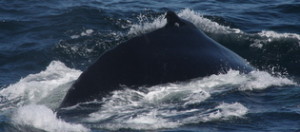
Nile
Nile, a female humpback was joined by Anvil and Echo. they appeared to have found a patch of fish and were doing open-mouthed lunges occasionally.
In the afternoon, we re-sighted Ventisca and her calf, seen earlier this week. Ventisca is easily distinguished by her bright-white dorsal fin. These two were traveling slowly — a good pace for us to get solid looks.
Ventisca and calf
We also re-sighted the mother and calf fin whale pair first seen earlier this week. The mother had been lunge feeding in the morning but in the evening was rather elusive. Fin whales are the second largest animal on the planet. In the photo, see how large even the calf is compared to the 8 foot dolphin in the background.
Even though the fin whales were characteristically elusive, the dolphins were extremely active, often traveling alongside the larger whales and occasionally leaping into the air. These dolphins are generally feeding on the small schooling fish as the larger whales, and it is not uncommon to see them in the same area.
May 6th was characterized by rough seas, but the humpback feeding we saw made it all worth it. Today was also noteworthy as it was one of the first days all season where we didn’t see a single right whale! Fortunately, there were a lot of humpbacks to watch. Photon, Plateau, Circus, Nocturne’s 2007 calf, and Vulture and her calf were kicking up a storm, corralling fish and gulping down huge mouthfuls.
In the afternoon, the wind had picked up even more and the wind was gusting from the southwest. We headed east to where the whales were in the morning, only to find that they had moved on. We had to turn west into the wind, where ocean spray soaked the upper deck! Finally, we found a huge bunch of feeding humpbacks — between 23 and 28!
Ventisca and her calf were back, as were Vulture and calf, Circus, Geometry, Plateau and Nocturne’s 2007 calf. Now that this whale has been seen several years in a row, it is eligible to get a name.
Nocturne’s 2007 calf







